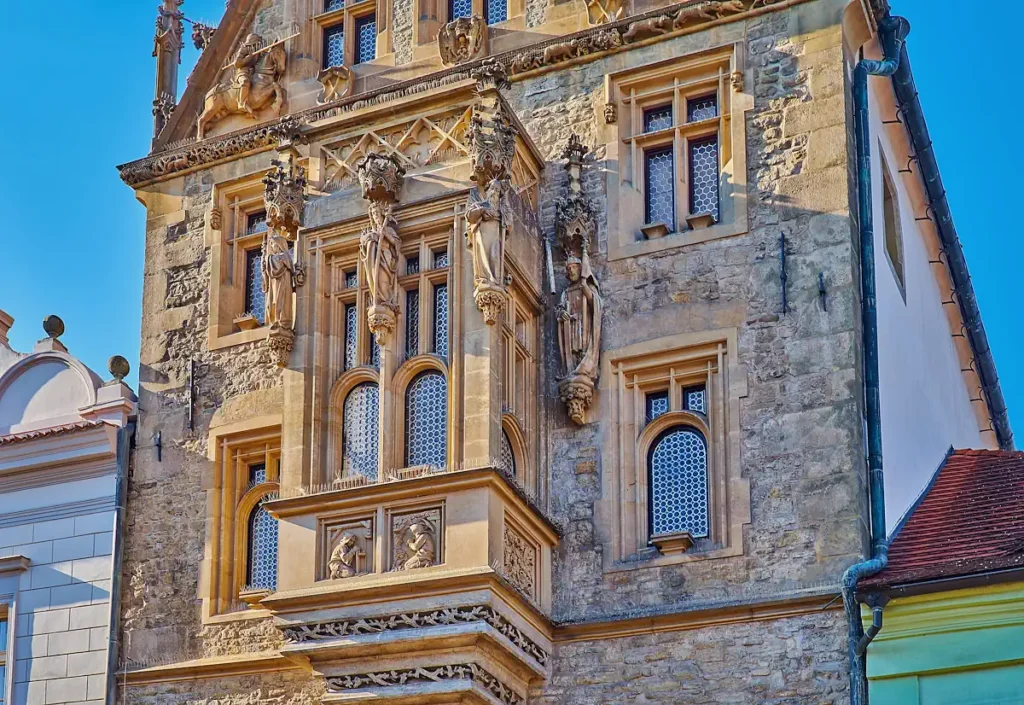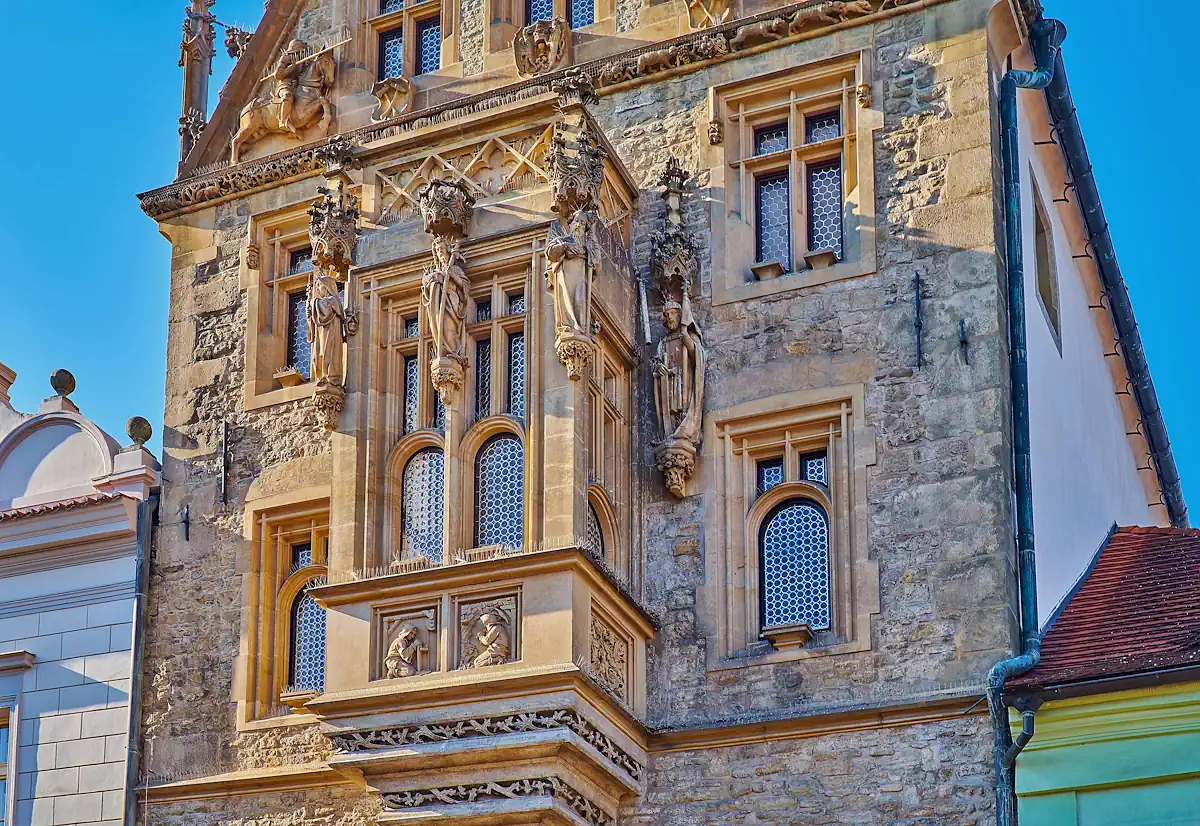Stone House
The Stone House in Kutná Hora is one of the most significant late Gothic burgher houses in the Czech Republic. From afar, it captivates with its richly decorated façade, full of symbols, animals, and figurative scenes. But behind its stone beauty lies much more than just aesthetics.
In medieval Europe, the nobility and the Church held the main power, while townspeople were “the others.” The Stone House demonstrates how an exceptionally strong burgher class emerged in Kutná Hora—wealthy, influential, and confident. The building shows that the riches from silver mining in the late Middle Ages began to flow beyond the nobility. The Stone House thus stands as proof of a changing social order. The Kutná Hora elite could afford houses that rivaled noble residences.
Behind the creation of the Stone House was Prokop Kroupa, a wealthy Kutná Hora townsman who traded silver and perhaps lent money to miners and nobles. In 1499, he was elevated to the nobility—an exceptionally rare honor for a burgher at that time. Kroupa had the house built to represent not only his wealth but also his newly gained status. The façade serves as a kind of “stone autobiography” expressing his faith, values, and ambitions.
Architecture – An Exceptional Example of Late Gothic
The façade of the Stone House is rare in the European context—such richly figurative burgher houses are more typical in some regions of German Gothic, but in the Czech lands, it has no direct equivalent. Stylistically, the building is close to cathedral architecture, which is unusual for urban houses of that era.
The Stone House is built from local marlstone, whose fine structure allowed detailed sculptural work. The house’s dominant feature is its richly articulated gable filled with sculptures depicting:
- Animal and natural motifs – a fox, bear, hare, leaves, branches, and flowers symbolizing the cycle of life.
- Knightly scenes – symbols of strength, loyalty, noble origin, or the desire for social advancement.
- Shepherd and sheep – motifs of peace and protection, with religious overtones.
- Tracery windows and Gothic arches – evidence of advanced stonemasonry craftsmanship.

The meaning of these scenes is often interpreted as a symbolic biography of Prokop Kroupa: his humble beginnings (shepherd), struggle for position (knightly duel), and triumphant attainment of a noble title.
In the decoration, two small sculptures can be found—a squirrel gnawing on a nut, symbolizing diligence and the accumulation of wealth (an image of the owner), and a drunkard with wine, serving as a warning against sin and corruption.
The stonemason Brikcius Gauske decorated the building, likely inspired by Gothic architecture from Saxony and Silesia (e.g., the town halls in Wrocław or Görlitz). The Stone House is a masterpiece of stonemasonry combining realistic scenes, fantastic motifs, and architectural details into one harmonious whole.
The house has two entrances—one representative, the other commercial. The left entrance led to formal rooms, while the right was used by suppliers and servants. The house was thus functionally divided, much like modern villas with separate sections. For a medieval burgher house, this was very unusual.
Who Were the Owners of the Stone House?
Prokop Kroupa (late 15th – early 16th century)
The original initiator of the house’s construction around 1485. 1485. A successful burgher and likely an entrepreneur in the silver industry. In 1499, he was ennobled—a truly exceptional social advancement. He had the Stone House built as an expression of his wealth and new status—the gable directly references his figure and the symbolism of knighthood. The Kroupa family owned the house for several generations.
Other Kutná Hora burghers (16th–18th centuries)
After the Kroupas, the house passed to other influential families. Some documents mention the Hřímalý and Valovský families, though records are incomplete. The house mainly served as a representative residence and business premises rather than a regular dwelling.
Town of Kutná Hora (19th century – present)
In the 19th century, the house became municipal property, used as the town hall and for administrative offices. In 1902, it underwent major restoration under Ludvík Lábler in the spirit of “regothicization.” Since 1910, the building has served exhibition purposes. Today, it is part of the Czech Museum of Silver.
Legends about the Stone House
The Tale of the Burning Fox
One legend tells that once every hundred years, the fox on the house “comes to life” to warn of a coming fire. People once believed that if someone saw the fox “change position” (for example, in the reflection of sunlight or shadow), it was a sign of impending misfortune.
The Ghost of Prokop Kroupa
Another tale claims that the ghost of Prokop Kroupa sometimes appears on the upper floor of the house. He is said to guard his legacy and ensure visitors understand what his house symbolized. His silhouette has reportedly been seen by moonlight in the window.
The Secret Cellar and the Lost Treasure
According to yet another legend, a secret cellar under the house once held Kroupa’s gold coins and valuable documents. During a city fire, it was buried and has never been found. They say the treasure still awaits its discoverer.
Visitor Information
Pro návštěvníky je památka otevřena k individuálním prohlídkám. Můžete zde vidět expozice Královské horní město – měšťanská kultura a život v 17. – 19. –19th Centuries and a lapidarium.
Opening hours:
Tue–Sun 10:00–18:00 (main season: May–September)
Tue–Sun 9:00–17:00 (shoulder season: April, October)
Closed off-season (December–January)
Lunch break: 12:00–12:30 Current opening hours can be found here.
Admission:
100 CZK adults
60 CZK students, seniors, children, and disabled visitors
270 CZK family ticket
Photography: allowed without restrictions.
Accessibility: not wheelchair accessible (stairs).
How to Get to the Stone House
On foot: Getting to the Stone House from the center of Kutná Hora is easy. From Palacký Square, walk uphill, turn right toward the Plague Column, and after about 150 meters you’ll see the house ahead.
By train: From Kutná Hora’s main station, it’s about 4.5 km to the center. If you have time, you can walk, but you’ll pass through the housing estate area, which is not very scenic. It’s better to take public transport or a taxi. You might also check if a train toward Zruč nad Sázavou is running—it stops two stations later at Kutná Hora město, close to the center. However, this connection is infrequent.
By car: There are several paid parking lots nearby, and street parking is possible. During the tourist season, parking can be more difficult, but you can usually find a spot in the vicinity.
Further links:

